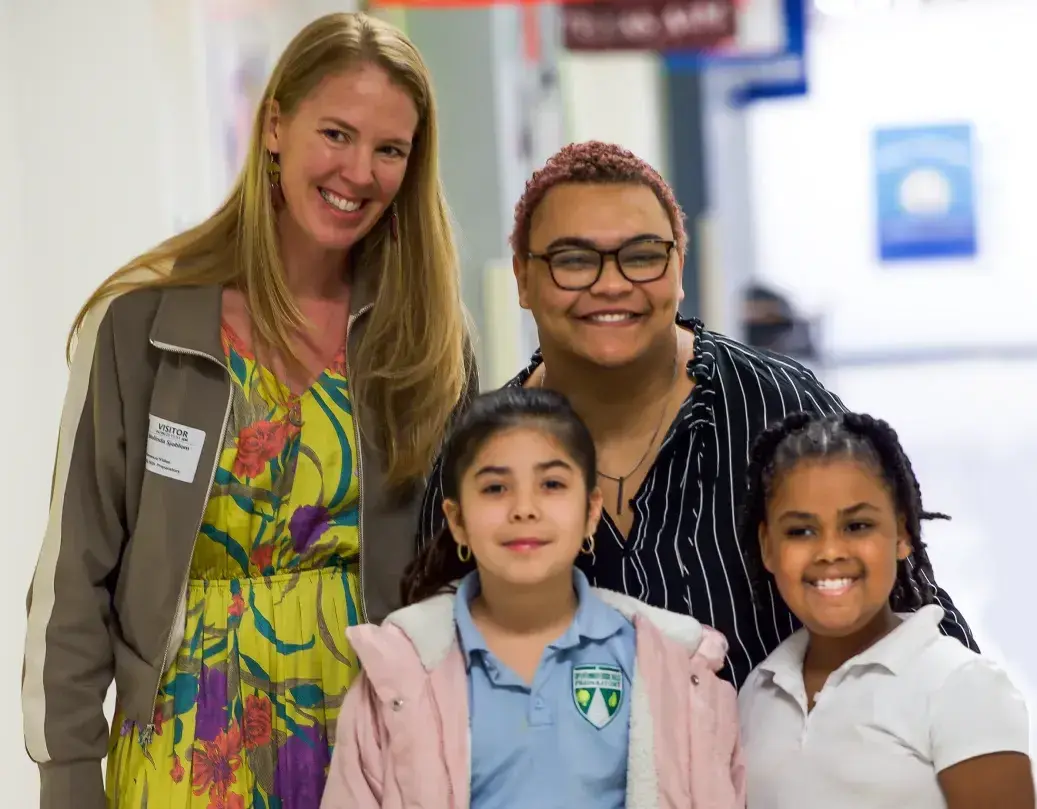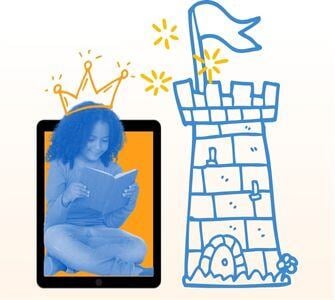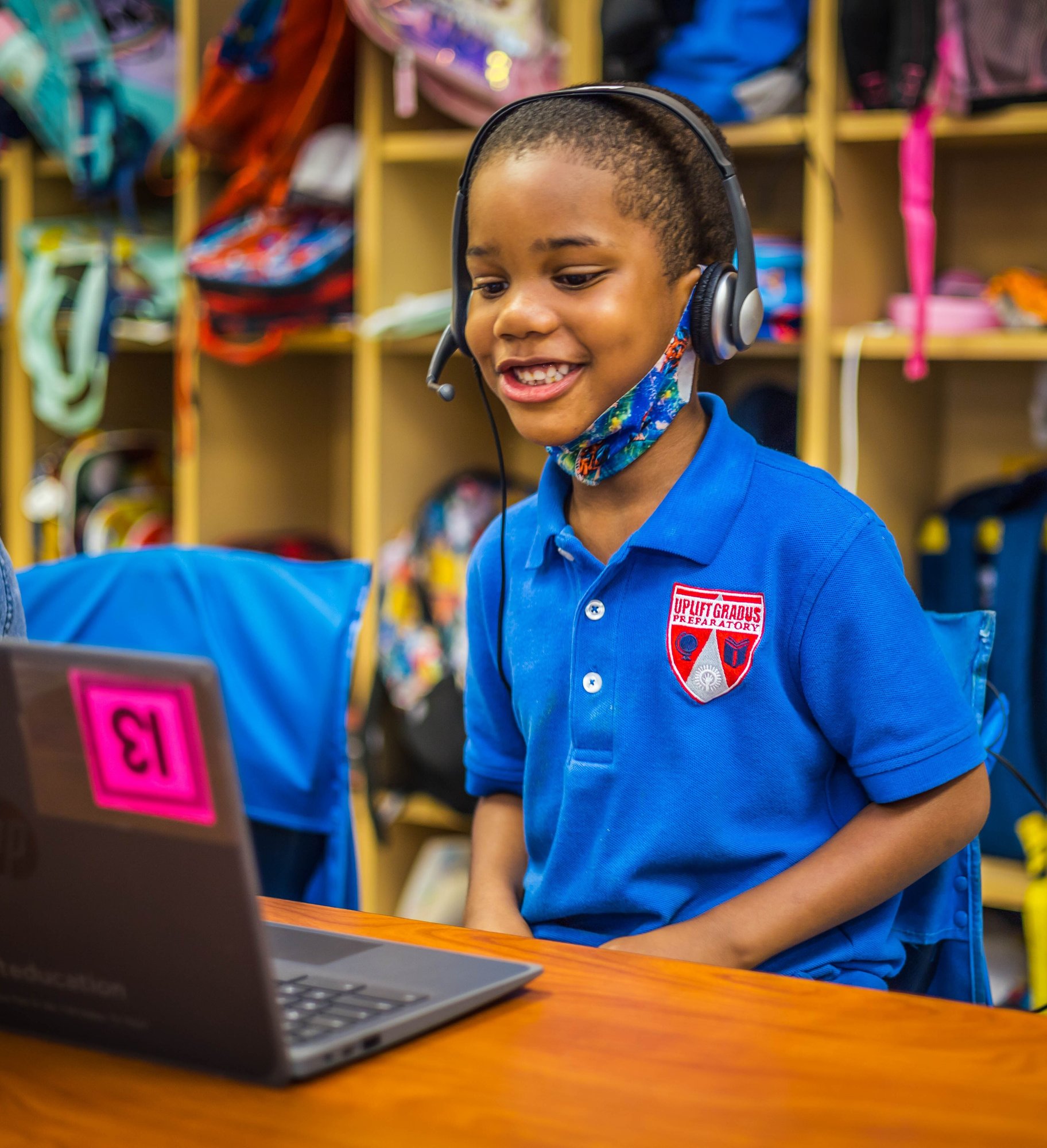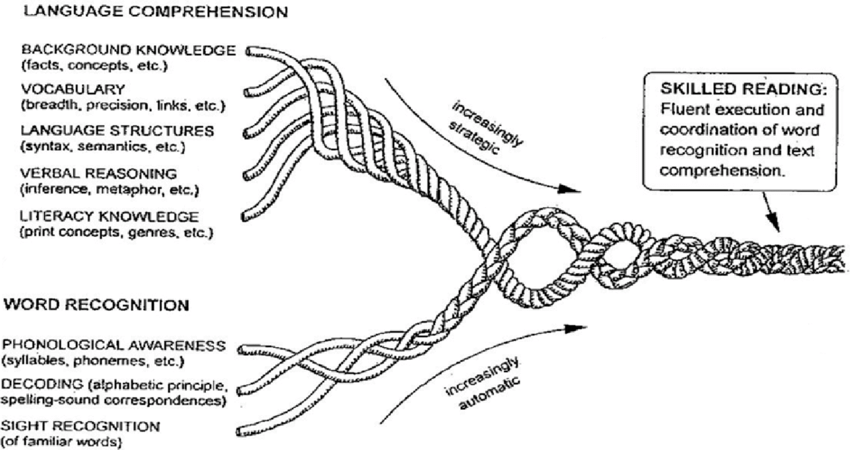What is the Science of Reading, and Why Does it Matter?
Unlock the power of evidence-based reading instruction. Explore the Science of Reading, discover practical strategies, and empower every student to become a confident reader.
Unlocking Literacy Success: Explore the research-backed principles of the Science of Reading, its impact on student achievement, and how it transforms reading instruction.
Is your literacy instruction setting students up for success? Recent data suggests that many schools are falling short.
Reading scores on the National Assessment of Educational Progress (NAEP) are down. Again. The scores for both 4th and 8th graders fell an average of two points from the already historically low scores seen in 2022.
That means it’s more important than ever to ensure that our children receive high-quality literacy instruction based on the Science of Reading.
The Science of Reading is the body of research that exists about how children best learn to read. Based on the research, there are five accepted pillars of the Science of Reading for early literacy: phonemic awareness, phonics, fluency, vocabulary, and comprehension. By understanding and applying the principles of the Science of Reading to our instruction, we can help all students reach their full potential.
That’s where OnYourMark Education comes in.
OnYourMark Education is dedicated to helping students achieve reading success through virtual high-impact tutoring. Our proven instructional methods, rooted in the Science of Reading, accelerate student learning and build a strong foundation for lifelong literacy. (Learn more about how OnYourMark can support your school’s literacy goals here.)
This page is designed to give you a comprehensive understanding of the Science of Reading, its practical application in the classroom, and how to implement it in your school.

Contents
What is the Science of Reading?
Before going too much further, let’s define Science of Reading. It's important to understand what the Science of Reading is and what it isn't. Let’s start with the isn’t stuff.
What the Science of Reading isn't...
The Science of Reading is not:
- A curriculum or a set of curricular materials
- A phonics program (phonics is just one part of how kids learn to read)
- Word recognition or language comprehension—again, these are only parts of what students need to learn how to read
...and what it is...
The Science of Reading is a body of research dating back more than 50 years. The result of this research is a huge mass of evidence proving how children best learn to read and why some students struggle with reading. It also informs our assessment of reading skills and how we can help learners “course-correct” to set them up for literacy success.
It includes five components, or “pillars”:
- Phonemic Awareness
- Phonics
- Fluency
- Vocabulary
- Comprehension
Kids progress through the pillars of literacy as they learn to become skilled readers.
It’s important to note that the Science of Reading is exactly that: a science. More than 50 years of research into the Science of Reading has culminated in an enormous body of evidence proving that this is how children learn to read best. Science is a study and therefore is ever-changing as we learn more and more. To paraphrase Maya Angelou: When we know better, we do better.
That’s why you’re hearing about the Science of Reading in the news and at back-to-school night—because states are starting to require that districts implement literacy curricula based on the Science of Reading because we know it’s what’s best for kids.
To learn more about The Science of Reading, check out these resources:

The 5 Pillars of Literacy
We know that literacy instruction based on the Science of Reading provides all children with the best chance to become successful readers. We now recognize five key pillars of literacy:
- Phonemic Awareness: The ability to hear, identify, and manipulate sounds in spoken words. For example, recognizing that "cat" and "hat" share similar sounds.
- Phonics: Understanding the relationship between letters and sounds, including decoding and spelling patterns. This involves using print, unlike phonemic awareness.
- Fluency: The ability to read text accurately, quickly, and with proper expression. Fluency comes with practice and improves comprehension.
- Vocabulary: Knowledge of words and their meanings. Vocabulary grows through reading, explicit instruction, and exposure to rich language.
- Comprehension: The ability to understand and make meaning from text. Comprehension is the ultimate goal of reading and is supported by all the other pillars.
The Science of Reading emphasizes explicit instruction in each of these pillars, to build a strong foundation for literacy success. When educators focus on these key components, they help students develop the skills they need to become confident and capable readers.
These resources can provide support as you deepen your understanding of the Science of Reading:
- Blog post: 5 Science of Reading Essentials for Your Classroom
- Free downloads: Activities for Tiered Literacy Instruction
If you're ready to start teaching the five pillars of literacy, this free eBook can help you get started with Phonemic Awareness. Download it today:
Why Does the Science of Reading Matter?
Reading proficiency fuels success across all subjects. Here’s why:
The Reading Rope and the Science of Reading
Scarborough’s Reading Rope demonstrates how different threads of language acquisition and literacy instruction need to come together for a child to become a proficient reader. The ultimate goal of reading—i.e., comprehension—develops when a student can engage in several complex processes at once. Those processes include early childhood literacy skills, like phonological awareness, letter recognition, and vocabulary. And those skills are essential here.
This blog post published by Amplify breaks down the connection between the Reading Rope and the Science of Reading:
The Reading Rope emphasizes the need for a comprehensive, deliberate approach to reading instruction. It recognizes that reading is not a singular skill, but rather a set of interwoven processes.
By understanding and addressing each of these processes (known in the Rope as strands), educators can provide the targeted instruction that helps readers succeed.
“Reading comprehension is the product, not the sum, of those two components. If one of them is zero, then overall reading ability is going to be zero,” says Jane Oakhill, Ph.D., professor of experimental psychology at the University of Sussex.
Starting in 3rd grade, the vocabulary in academic texts becomes more complex, and the number of vocabulary words students need to know increases dramatically. Thankfully, many of these words can be decoded easily once students have mastered early foundational reading skills identified by the Science of Reading.
But, as students advance to 4th grade and beyond, the number of new words they'll need to read, understand, and apply skyrockets. In 1995, Professor David L. Share famously called this the "orthographic avalanche," noting that students will likely encounter roughly 10,000 new words in 5th grade, jumping to 70,000 new words by 7th grade.
The sheer volume of new words makes it impossible for teachers to provide explicit instruction for each one and still teach highly complex content. That means that without mastery of foundational language and word recognition skills, students won't become skilled readers who can comprehend what they are reading. As a result, they fall further and further behind academically and miss out on the opportunities that come from academic success. We examined this in detail in this blog post.
Implementing the Science of Reading
We now know so much about the Science of Reading, current reading scores, and the urgent need for changes to the way we teach kids to read. But how do we actually make reading progress?
Use Cross-Curricular Literacy Instruction in Your School and District
Literacy skills impact learning across all subjects. Research shows that proficient readers are better equipped to tackle higher-level academic tasks, like complex math problems, scientific data analysis, and historical interpretations. In every subject area, students need the literacy skills they've developed early on to acquire new knowledge.
Here are some proven ways to embed literacy instruction across the curriculum:
- Pre-teach or front-load unit or lesson vocabulary
- Annotate or mark up the text
- Write to learn
For more on these strategies, click here.
Choose Science of Reading-based Literacy Curriculum
Selecting the right literacy curriculum and assessments is absolutely crucial for student success. Ensure the materials and assessments are aligned with your state's learning standards and your school or district's overall literacy goals, as a cohesive approach across all grade levels is essential.
Next, focus on programs based on the Science of Reading. Programs grounded in the Science of Reading provide explicit and systematic instruction in each pillar of literacy—proven by research to be crucial for developing strong decoding skills and reading comprehension. Some programs, such as Amplify mCLASS, used in OnYourMark Education’s virtual high-impact tutoring programming, are designed with the Science of Reading principles in mind.
Then, consider the data and information gathered about student learning. Data-driven instruction is how you meet each student’s needs.
That means the assessments you use should not only measure student progress but also give insights into specific skill gaps, allowing teachers to tailor their instruction. Look for programs that offer a variety of assessments, including diagnostic assessments to identify specific areas of need (such as DIBELS, which OnYourMark Education uses in its high-dosage tutoring program), formative assessments to monitor student learning, and summative assessments to evaluate overall progress.
Finally, effective implementation of any curriculum requires ongoing professional development for your teachers. Ask about the professional learning opportunities offered by the curriculum provider to ensure your teachers are well-equipped to use the materials effectively.
Mini-Checklist for Evaluating Curriculum and Assessment Materials
To help you evaluate curriculum and assessment materials effectively, use this checklist as a guide:
Essential
Are the materials and assessments aligned with my state's standards for early literacy?
Does the program provide explicit and systematic instruction in each literacy pillar?
Does the program include assessments that measure all five pillars of reading?
Recommended
Is the program based on research-proven principles of reading instruction?
Are there opportunities for students to practice reading connected text?
What initial training and ongoing professional development opportunities exist for teachers?
Considerations
Is the program cost-effective and sustainable for our budget?
Of course, budget is always a concern, but investing in a less expensive program that doesn’t deliver results is, ultimately, a waste of precious resources.
Empower Your Teachers with Science of Reading Professional Development
While the Science of Reading provides a research-based framework for understanding how children learn to read, simply adopting new curriculum materials isn't enough. Teachers need deep knowledge of the Science of Reading principles to implement those materials effectively and differentiate instruction to meet the needs of all learners.
Investing in professional development pays off with big returns for your teachers and students. Here’s why:

- Deepen understanding: Ongoing professional development allows teachers to deepen their understanding of the five pillars of reading and how they interact. This knowledge empowers them to make informed instructional decisions and more effectively differentiate their instruction.
- Refine skills: Through PD, teachers can refine their skills in explicit and systematic phonics instruction, vocabulary development strategies, and comprehension-building techniques. This leads to more effective and engaging literacy instruction.
- Stay up-to-date: As we’ve mentioned, the field of literacy research is constantly evolving. Ongoing PD helps teachers stay on top of the latest findings and best practices in the Science of Reading, allowing them to continuously reflect on and improve their instruction.
- Build confidence: By deepening their knowledge and skills, teachers gain confidence in their ability to implement the Science of Reading effectively. This confidence translates into more effective teaching and better outcomes for students.
Effective Professional Development
The best PD is applicable PD. Any professional development should provide your teachers with practical strategies and continual support. Here’s what to look for:
- Targeted workshops and training sessions: High-quality workshops and training sessions provide in-depth instruction on specific aspects of the Science of Reading, such as phonemic awareness activities, effective phonics instruction, or strategies for building vocabulary.
- Opportunities for coaching and mentoring: One-on-one coaching or mentoring from literacy experts can provide personalized support and guidance for teachers as they implement the Science of Reading in their classrooms.
- Time for teachers to meet in professional learning communities/teams (PLCs/PLTs): Create time for teachers to share best practices, discuss challenges, and learn from each other's experiences with the Science of Reading.
- Sharable online courses and resources: Targeted online courses, webinars, and digital resources offer flexible and accessible options for teachers to deepen their knowledge of the Science of Reading at their own pace.
Remember that PD is not a one-time event. Investing in ongoing professional development is an investment in your teachers and, ultimately, in your students. By providing teachers with the knowledge, skills, and support they need to implement the Science of Reading effectively today, you are supporting your teachers as they work to create a foundation for literacy success for all learners, benefitting your school for years to come.

The Science of Reading: Addressing Common Concerns and Roadblocks
While the benefits of the Science of Reading are clear, the path to implementation…? That isn’t always smooth. Schools and districts often tell us about the obstacles in their way.
Common objections we see include:
- Resistance to change and getting buy-in: Some teachers may be resistant to new approaches, especially if they've been using different methods for a long time.
- Misconceptions about the Science of Reading: There might be misunderstandings about what the Science of Reading actually is and what it entails.
- Lack of resources: Schools may lack the funding or materials needed to fully implement Science of Reading-based instruction.
- Time constraints: Finding the time for professional development, curriculum changes, and ongoing support can be difficult.
- Providing individualized support: Addressing the diverse needs of all learners, including those with disabilities or those learning English as a second language, can present additional challenges.
We encourage you to be proactive. Address these challenges head-on to pave the way for a successful Science of Reading approach with your community.
Building Buy-in for the Science of Reading
Educators, especially seasoned educators, see changes come and go every year. Often, these changes are imposed upon them and their voices are unheard. It’s important to acknowledge those feelings with validating statements (do not use the word “but” in those statements!).
With that in mind,
- Provide clear and compelling evidence about the effectiveness of the Science of Reading. Share research findings, student success stories, and testimonials from other educators.
- Involve teachers in the decision-making process and provide opportunities for them to share their concerns and feedback.
- Start with small, manageable changes and celebrate everyone’s contributions to successes along the way to build momentum.
Debunking Misconceptions about the Science of Reading
While the Science of Reading isn’t new, we've seen it resurface over the past 5 years due to recent media coverage and pandemic-related student literacy struggles. But the Science of Reading isn’t a trend or some “new thing” in education; it’s a well-established, research-based approach to literacy instruction.
- Offer clear and concise explanations of what the Science of Reading is and what it is not. Come prepared to debunk common myths and misconceptions.
- Provide access to high-quality resources, such as articles, books, and websites, that explain the Science of Reading in plain language. This blog post lists some of our favorites!
- Invite experts to speak to your staff or community about the Science of Reading and its benefits.
Maximizing Resources for Science of Reading Implementation
Explore creative funding options and prioritize essential materials and resources that will have the greatest impact on student learning (take a look at our funding page for ideas!).
And take advantage of free or low-cost resources, such as online tools, open educational resources, and teacher collaboration.
Navigating Time Constraints with Your Staff
Remember that time is a resource. Be mindful of the amount of time you require of your teachers. Support their schedules in the following ways:
- Embed professional development into existing schedules, such as staff meetings or early release days.
- Provide flexible PD options, such as online courses or self-paced modules.
- Encourage teacher collaboration and peer-to-peer support to maximize learning and implementation.
And, once in a while, cancel a meeting to give time back to your teachers. They’ll thank you for it.
Check out this article to navigate Science of Reading literacy instruction and staffing challenges.
Meeting the Diverse Needs of Your Students
Every student is unique, and their literacy journeys will be different. You can support each student by
- Ensuring that curriculum materials and assessments are culturally responsive and meet the needs of diverse learners.
- Providing differentiated instruction and support for students with disabilities or those learning English as a second language.
- Collaborating with specialists and support staff to address the unique needs of individual students.
Embrace a Growth Mindset for Continuous Improvement
As educators, we constantly remind our students that learning is a process. Yet we sometimes forget that change is a learning process that also takes time and effort.
Take a moment to reflect on your own mindset and how you can model a growth mindset for your team. Validate bumps in the road and acknowledge and praise the wins along the way.

Scale Your Literacy Support with High-Impact Tutoring
High-dosage tutoring, also known as high-impact tutoring, helps schools boost student learning, address staffing shortages, and close skill gaps by bringing in well-trained tutors to provide targeted, consistent instruction. This work can be done in person or by partnering with a virtual tutoring program. Research shows that high-dosage tutoring is one of the most effective ways to accelerate student learning, especially for those who are struggling.
OnYourMark Education provides virtual high-impact literacy tutoring and is one of the first tutoring providers proven to be effective in a randomized controlled trial. (You can read the research conducted by the National Student Support Accelerator [NSSA] at Stanford University here.)

Our highly-trained tutors prepare scripted, Science of Reading-based lessons customized to meet individual students' needs. Our tutors support classroom instruction and guide students toward grade-level proficiency. Our proven approach helps students make significant gains in reading, build confidence, and develop a love of learning.
Download our free eBook, The Ultimate Guide to High-Impact Tutoring, to see how high-dosage tutoring accelerates students’ literacy growth, and what to look for in a tutoring provider.
Partnering with OnYourMark
We seamlessly integrate our expert tutors into your school day and work with your team to provide flexible scheduling options that minimize disruption to classroom instruction.
Using DIBELS screeners to drive skill instruction, our tutors personalize learning for every student through customized lesson plans and individualized support.
OnYourMark tutors conduct regular progress monitoring. They also provide your team with detailed reports and ongoing support, giving you valuable insights into student growth and program effectiveness.
And because OnYourMark is a virtual tutoring provider, our solution fits within your current technology resources and is scalable, so we can support more students during your school day.
With OnYourMark, you're not just addressing a learning gap—you're opening a world of opportunity for every student.
Meet with our team today to learn more about high-dosage tutoring for your students.
Resources and Further Learning
We’ve compiled a great list of Science of Reading tools in this blog post, and here are some additional resources to help you explore the Science of Reading:
From Our Blog
External Links
Find links to reputable research articles and organizations.
Downloads
Free downloads to guide literacy instruction.
Conclusion
The Science of Reading is a time-tested evidence-based approach to literacy instruction. By choosing curricula and assessments that foster explicit and systematic instruction of phonics phonemic awareness, fluency, vocabulary, and comprehension, you help students build a foundation for future success in education and well beyond the classroom.
Contact us to get started with high-impact tutoring for your students.
Contributors
- Mindy Sjoblom, Founder and CEO, OnYourMark Education
- Jamie Thomas, Senior Director of Program, OnYourMark Education
- Caitlin Kindred, Senior Marketing Manager, OnYourMark Education




